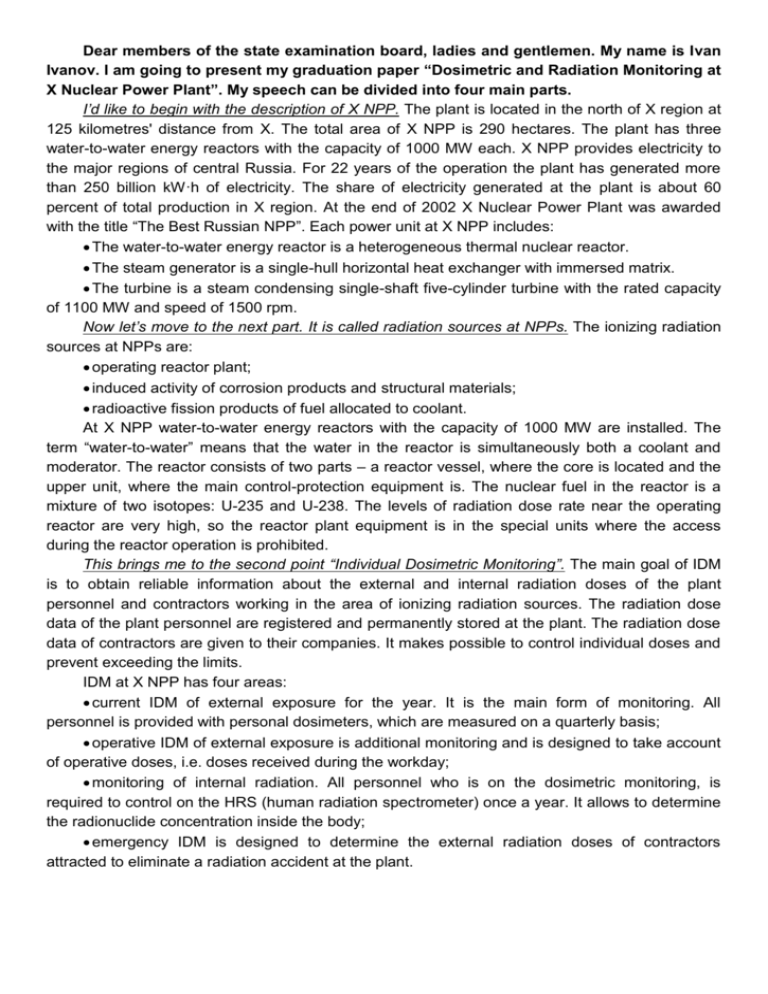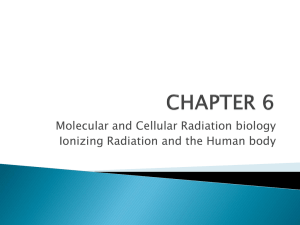Dear members of the state examination board, ladies and
advertisement

Dear members of the state examination board, ladies and gentlemen. My name is Ivan Ivanov. I am going to present my graduation paper “Dosimetric and Radiation Monitoring at X Nuclear Power Plant”. My speech can be divided into four main parts. I’d like to begin with the description of X NPP. The plant is located in the north of X region at 125 kilometres' distance from X. The total area of X NPP is 290 hectares. The plant has three water-to-water energy reactors with the capacity of 1000 MW each. X NPP provides electricity to the major regions of central Russia. For 22 years of the operation the plant has generated more than 250 billion kW·h of electricity. The share of electricity generated at the plant is about 60 percent of total production in X region. At the end of 2002 X Nuclear Power Plant was awarded with the title “The Best Russian NPP”. Each power unit at X NPP includes: The water-to-water energy reactor is a heterogeneous thermal nuclear reactor. The steam generator is a single-hull horizontal heat exchanger with immersed matrix. The turbine is a steam condensing single-shaft five-cylinder turbine with the rated capacity of 1100 MW and speed of 1500 rpm. Now let’s move to the next part. It is called radiation sources at NPPs. The ionizing radiation sources at NPPs are: operating reactor plant; induced activity of corrosion products and structural materials; radioactive fission products of fuel allocated to coolant. At X NPP water-to-water energy reactors with the capacity of 1000 MW are installed. The term “water-to-water” means that the water in the reactor is simultaneously both a coolant and moderator. The reactor consists of two parts – a reactor vessel, where the core is located and the upper unit, where the main control-protection equipment is. The nuclear fuel in the reactor is a mixture of two isotopes: U-235 and U-238. The levels of radiation dose rate near the operating reactor are very high, so the reactor plant equipment is in the special units where the access during the reactor operation is prohibited. This brings me to the second point “Individual Dosimetric Monitoring”. The main goal of IDM is to obtain reliable information about the external and internal radiation doses of the plant personnel and contractors working in the area of ionizing radiation sources. The radiation dose data of the plant personnel are registered and permanently stored at the plant. The radiation dose data of contractors are given to their companies. It makes possible to control individual doses and prevent exceeding the limits. IDM at X NPP has four areas: current IDM of external exposure for the year. It is the main form of monitoring. All personnel is provided with personal dosimeters, which are measured on a quarterly basis; operative IDM of external exposure is additional monitoring and is designed to take account of operative doses, i.e. doses received during the workday; monitoring of internal radiation. All personnel who is on the dosimetric monitoring, is required to control on the HRS (human radiation spectrometer) once a year. It allows to determine the radionuclide concentration inside the body; emergency IDM is designed to determine the external radiation doses of contractors attracted to eliminate a radiation accident at the plant. The next issue in my presentation is Radiation Monitoring. Continuous radiation monitoring of the environment in a supervised area is carried out by an automated system of radiation situation monitoring. The content of radionuclides in soil, water, precipitation and vegetation is carried out by laboratory methods. The radiation safety is the timely receipt of accurate and complete information about the radiation situation at the plant during the normal operation and in case of an emergency. This function at X NPP is performed by Radiation Safety Department. RSD monitors the radiation parameters and provides the necessary information about the radiation situation. The final issue of my presentation is Ecology. X NPP gives high priority to environment protection. In the last three years X NPP has been the best in Russia in terms of radiation safety. The monitoring is carried out in the following directions: hydrology; meteorology; water level, temperature and chemistry; seismology; foundation settlement and deformation; Earth crust and gravity field movement; radiology; human health; animal health. In conclusion I’d like to mention that the power units of X NPP with their water-to-water energy reactors meet the highest national and international safety standards. In order to further enhance its safety, efficiency and competitiveness, the plant has conducted a number of measures. So, that is all for the moment. Thank you for listening. And now I’m open to any questions you might have.







